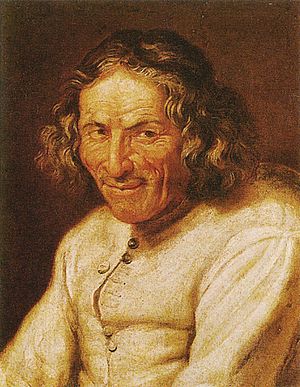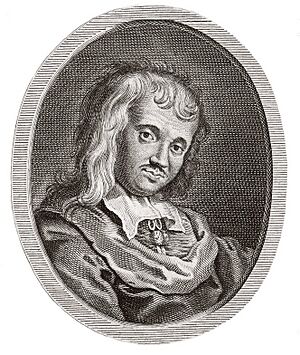Paul Scarron facts for kids

Paul Scarron (born around July 1, 1610, in Paris – died October 6, 1660, in Paris) was a French poet, writer of plays (dramatist), and novelist. He was baptized on July 4, 1610. Scarron was the first husband of Françoise d'Aubigné, who later became Madame de Maintenon. She secretly married King Louis XIV of France.
Life Story
Paul Scarron was the seventh child of Paul Scarron, a noble who worked in law and government (a noble of the robe) and was part of the Parlement of Paris. His mother was Gabrielle Goguet.
When he was nineteen, Paul became an abbé, which is a type of clergyman. He lived in Le Mans from 1632 to 1640. In 1635, he traveled to Rome with his supporter, Charles de Beaumanoir, who was the bishop of Le Mans. He found another supporter in Marie de Hautefort, a close friend of King Louis XIII. This helped him become well-known in the world of literature and high society.
In 1638, Scarron became disabled. Some stories say his body became twisted and his legs paralyzed because he spent time in a swamp. Another story says he fell into an ice-cold bath during a carnival. It is now thought that he likely became disabled from polio, a disease often linked to water.
Whatever the reason, Scarron began to suffer a lot of pain. His upper body became permanently twisted, and his legs could not move. He had to use a wheelchair. On top of this, he had many lawsuits with his stepmother over his father's property. He also had to support his sisters financially.
Scarron moved back to Paris in 1640. In 1643, he published a collection of funny poems called Recueil de quelques vers burlesques. The next year, he published Typhon ou la gigantomachie. While in Le Mans, he started writing his famous Roman comique (Comic Novel). The first part of this book was printed in 1651.
In 1645, his play Jodelet, ou le maître valet (Jodelet, or the Valet as Master) became popular. The main actor was also named Jodelet. This play was one of the first French comedies where a servant pretends to be the master. Scarron got this idea from Spanish plays.
Scarron worked for a bookseller named Quinet. He also received money (a pension) from Nicolas Fouquet and from the queen. Scarron had first dedicated his work Typhon to Cardinal Mazarin. When Mazarin was not impressed, Scarron changed it to make fun of Mazarin. In 1651, he wrote a strong pamphlet against Mazarin, supporting a rebellion called the Fronde. Because of this, he lost his pensions.
In 1652, he married Françoise d'Aubigné, who was poor but beautiful. She later became famous as Madame de Maintenon, the second wife of Louis XIV. Paul Scarron died in Paris on October 6, 1660.
Scarron's Epitaph
Scarron wrote his own epitaph, which is a short text on a tombstone. It talks about the terrible physical pain he felt during his last years:
- Celui qui cy maintenant dort
- Fit plus de pitié que d'envie,
- Et souffrit mille fois la mort
- Avant que de perdre la vie.
- Passant, ne fais ici de bruit
- Garde bien que tu ne l'éveilles :
- Car voici la première nuit
- Que le pauvre Scarron sommeille.
This means:
- "He who sleeps here now
- Deserved more pity than envy,
- And suffered death a thousand times
- Before losing his life.
- Passer-by, do not make noise here
- Be careful not to wake him
- Because this is the first night
- That poor Scarron slumbers."
His Works
Scarron wrote many books and plays. His most famous work in his own time was Virgile travesti (1648–1653). This was a funny version (a parody) of the ancient Roman epic poem Aeneid. However, this work is not as well-known today.
His best work is considered to be the Roman comique (Comic Novel) from 1651–1657. This book tells the story of a group of traveling actors. It was one of the first French novels to truly show how people lived and acted. It is written in the style of Spanish picaresque novels, which follow the adventures of a clever but often poor hero. This book later gave the writer Théophile Gautier ideas for his novel Capitaine Fracasse.
Scarron also wrote shorter stories (novellas). One, La Precaution inutile, inspired another play. His plays include Jodelet (1645), Don Japhet d'Arménie (1653), and L'Écolier de Salamanque (1654). Many of his works were based on Spanish stories, especially those by Tirso de Molina and Francisco de Rojas Zorrilla.
Paul Scarron is also a character in the famous book Twenty Years After by Alexandre Dumas.
About The Roman Comique
The Roman Comique describes the adventures of a group of traveling actors. It shows a realistic picture of how these acting companies lived and worked. The main story follows the troubles of Destin's acting company. The book has a narrator who sometimes steps in to talk to the reader. Some characters also tell their own life stories, which are more serious and often about love among noble people.
By the end, the reader learns many secrets and how the serious past stories connect to the funny adventures of the present. For example, a character named L'Estoile is actually the noble Leonore in disguise. The novel also gets some of its humor from Miguel de Cervantes's Don Quixote. It also includes four extra tales, mostly from Spanish sources. The most famous is "The Invisible Mistress," a funny version of a more serious tale. This story was later rewritten by English authors like Thomas Otway.
See also
 In Spanish: Paul Scarron para niños
In Spanish: Paul Scarron para niños


